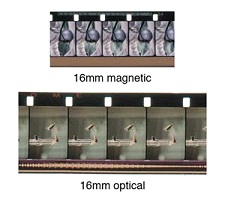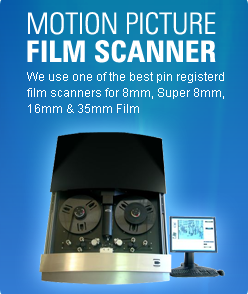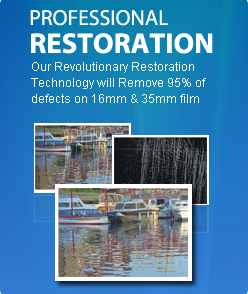
Regular 8mm movie film was never sold commercially with a sound strip but some people did attach a sound strip themselves. Super 8 film has the option but you had to buy the film with the sound strip on it and you had to have a sound camera and microphone. 16mm had both magnetic and optical. On the order form you can let us know if you think your film has sound on it. It does take extra effort to capture the sound and incorporate it into the requested formats. So, we do charge a little more for sound film.
We can not capture any digital audio like Dolby Digital or Sony Dynamic Digital Sound.


The above picture is just an example. 16mm sound film came in many different varieties. 16mm film with optical sound will have sprocket holes on 1 side. The other side will carry the audio track.
There is no sound on Regular 8 film. At least it wasn't produced that way. There were some people that put a magnetic sound strip on 8mm film themselves. There was also some test 8mm film with sound that Kodak used to prepare for Super 8 film.
Even though Super 8 film was sold in two versions, sound and silent, most Super 8 film is silent. Only about 5% of all Super 8 movie film has sound on it.
Super 8 sound could be recorded with a microphone during filming or could also be recorded using a projector when the film played. The quality of the sound varied widely.
Pittsburgh Fun Facts: Pittsburgh is located in southwestern Pennsylvania at the confluence of three rivers: the Allegheny, the Monongahela and the Ohio. Known as the Steel City, Pittsburgh emerged in the late 1800s as a world center for coal and steel. Despite setbacks to the steel industry and a population decline over the last few decades, Pittsburgh remains the state's second-largest city and an important industrial center. Today, Pittsburgh is a city of 400,000, with a diversified economy that embraces high tech companies such as Rockwell Automation and financial services companies such as Mellon Financial and PNC Financial.
Pennsylvania Fun Facts: One of the original 13 colonies, Pennsylvania was founded by William Penn as a haven for his fellow Quakers. Pennsylvania’s capital, Philadelphia, was the site of the first and second Continental Congresses in 1774 and 1775, the latter of which produced the Declaration of Independence, sparking the American Revolution. After the war, Pennsylvania became the second state, after Delaware, to ratify the U.S. Constitution.





